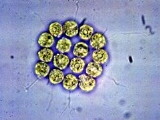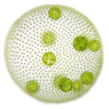
Volvocaceae
Encyclopedia
The Volvocaceae are a family
of unicellular or colonial biflagellates, including the typical genus
Volvox
. The family was named by Ehrenberg in 1834, and is known in older classifications as the Volvocidae.
and embedded in a gelatinous matrix. In the genus Gonium
, for example, each individual organism is a flat plate consisting of 4 to 16 separate cells, each with two flagella
. Similarly, the genera Eudorina
and Pandorina
form hollow spheres, the former consisting of 16 cells, the latter of 32 to 64 cells. In these genera each cell can reproduce a new organism by mitosis
.
 Other genera of Volvocaceans represent another principle of biological development as each organism develops differented cell types. In Pleodorina
Other genera of Volvocaceans represent another principle of biological development as each organism develops differented cell types. In Pleodorina
and Volvox
, most cells are somatic
and only a few are reproductive. In Pleodorina californica a colony normally has either 128 or 64 cells, of which those in the anterior region have only a somatic function, while those in the posterior region can reproduce; the ratio being 3:5. In Volvox only very few cells are able to reproduce new individuals, and in some species of Volvox the reproductive cells are derived from cells looking and behaving like somatic cells. In V. carteri
, on the other hand, the division of labor is complete with reproductive cells being set aside during cell division, and they never assume somatic functions or develop functional flagella.
Thus, the simplest Volvocaceans are colonial organisms but others are truly multicellular organisms. Larger volvocaceans have evolved a specialized form of heterogamy
called oogamy
, the production of small motile
sperm by one mating type and relatively larger immotile eggs by another. Among the Volvocaceans are thus the simplest organisms with distinguishable male and female members. In all Volvocaceans, the fertilization reaction results in the production of a dormant diploid zygote
(zygospore
) capable of surviving in harsh environments. Once conditions have improved the zygospore germinates and undergoes meiosis
to produce haploid offspring of both mating types.
Family (biology)
In biological classification, family is* a taxonomic rank. Other well-known ranks are life, domain, kingdom, phylum, class, order, genus, and species, with family fitting between order and genus. As for the other well-known ranks, there is the option of an immediately lower rank, indicated by the...
of unicellular or colonial biflagellates, including the typical genus
Genus
In biology, a genus is a low-level taxonomic rank used in the biological classification of living and fossil organisms, which is an example of definition by genus and differentia...
Volvox
Volvox
Volvox is a genus of chlorophytes, a type of green algae. It forms spherical colonies of up to 50,000 cells. They live in a variety of freshwater habitats, and were first reported by Antonie van Leeuwenhoek in 1700. Volvox developed its colonial lifestyle .-Description:Volvox is the most developed...
. The family was named by Ehrenberg in 1834, and is known in older classifications as the Volvocidae.
Description
The simplest of the Volvocaeans are ordered assemblies of cells, each similar to the related unicellar protist ChlamydomonasChlamydomonas
Chlamydomonas is a genus of green algae. They are unicellular flagellates. Chlamydomonas is used as a model organism for molecular biology, especially studies of flagellar motility and chloroplast dynamics, biogenesis, and genetics...
and embedded in a gelatinous matrix. In the genus Gonium
Gonium
Gonium is a genus of colonial algae, a member of the order Volvocales. Typical colonies have 4 to 16 cells, all the same size, arranged in a flat plate, with no anterior-posterior differentiation. In a colony of 16 cells, four are in the center, and the other 12 are on the four sides, three each....
, for example, each individual organism is a flat plate consisting of 4 to 16 separate cells, each with two flagella
Flagellum
A flagellum is a tail-like projection that protrudes from the cell body of certain prokaryotic and eukaryotic cells, and plays the dual role of locomotion and sense organ, being sensitive to chemicals and temperatures outside the cell. There are some notable differences between prokaryotic and...
. Similarly, the genera Eudorina
Eudorina
In taxonomy, Eudorina is a genus of colonial green algae, specifically of the Volvocaceae. Eudorina colonies consist of 32 individual cells grouped together. Each individual cell contains flagella which allow the colony to move as a whole when the individual cells beat their flagella together...
and Pandorina
Pandorina
Pandorina is a genus of green algae composed of 8, 16, or sometimes 32 cells, held together at their bases to form a sack globular colony surrounded by mucilage. The cells are ovoid or slightly narrowed at one end to appear keystone- or pear-shaped...
form hollow spheres, the former consisting of 16 cells, the latter of 32 to 64 cells. In these genera each cell can reproduce a new organism by mitosis
Mitosis
Mitosis is the process by which a eukaryotic cell separates the chromosomes in its cell nucleus into two identical sets, in two separate nuclei. It is generally followed immediately by cytokinesis, which divides the nuclei, cytoplasm, organelles and cell membrane into two cells containing roughly...
.

Pleodorina
In taxonomy, Pleodorina is a genus of colonial green algae, specifically of the Volvocaceae. Description by Gilbert M. Smith .Pleodorina Shaw 1894:...
and Volvox
Volvox
Volvox is a genus of chlorophytes, a type of green algae. It forms spherical colonies of up to 50,000 cells. They live in a variety of freshwater habitats, and were first reported by Antonie van Leeuwenhoek in 1700. Volvox developed its colonial lifestyle .-Description:Volvox is the most developed...
, most cells are somatic
Somatic cell
A somatic cell is any biological cell forming the body of an organism; that is, in a multicellular organism, any cell other than a gamete, germ cell, gametocyte or undifferentiated stem cell...
and only a few are reproductive. In Pleodorina californica a colony normally has either 128 or 64 cells, of which those in the anterior region have only a somatic function, while those in the posterior region can reproduce; the ratio being 3:5. In Volvox only very few cells are able to reproduce new individuals, and in some species of Volvox the reproductive cells are derived from cells looking and behaving like somatic cells. In V. carteri
Volvox carteri
Volvox carteri F.Stein 1873 is a species of colonial green algae in the order Volvocales. V. carteri forms large spherical colonies, or coenobium, of 2000-6000 Chlamydomonas type cells. Colonies contain mostly somatic cells plus a smaller number of gametes in female or male colonies...
, on the other hand, the division of labor is complete with reproductive cells being set aside during cell division, and they never assume somatic functions or develop functional flagella.
Thus, the simplest Volvocaceans are colonial organisms but others are truly multicellular organisms. Larger volvocaceans have evolved a specialized form of heterogamy
Heterogamy
Heterogamy has a number of biological definitions:*In reproductive biology, heterogamy is the alternation of differently organized generations, applied to the alternation between parthenogenetic and a sexual generation...
called oogamy
Oogamy
Oogamy is the familiar form of sexual reproduction. It is a form of anisogamy in which the female gamete is significantly larger than the male gamete and is non-motile. The male gametes are typically highly motile spermatozoa competing for the fertilization of the immotile egg.By contrast to...
, the production of small motile
Motility
Motility is a biological term which refers to the ability to move spontaneously and actively, consuming energy in the process. Most animals are motile but the term applies to single-celled and simple multicellular organisms, as well as to some mechanisms of fluid flow in multicellular organs, in...
sperm by one mating type and relatively larger immotile eggs by another. Among the Volvocaceans are thus the simplest organisms with distinguishable male and female members. In all Volvocaceans, the fertilization reaction results in the production of a dormant diploid zygote
Zygote
A zygote , or zygocyte, is the initial cell formed when two gamete cells are joined by means of sexual reproduction. In multicellular organisms, it is the earliest developmental stage of the embryo...
(zygospore
Zygospore
A zygospore is a diploid reproductive stage in the life cycle of many fungi and protists. Zygospores are created by the nuclear fusion of haploid cells. In fungi, zygospores are termed chlamydospores and are formed after the fusion of hyphae of different mating types...
) capable of surviving in harsh environments. Once conditions have improved the zygospore germinates and undergoes meiosis
Meiosis
Meiosis is a special type of cell division necessary for sexual reproduction. The cells produced by meiosis are gametes or spores. The animals' gametes are called sperm and egg cells....
to produce haploid offspring of both mating types.

